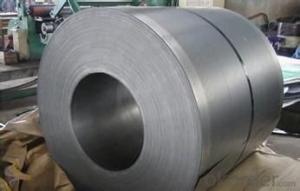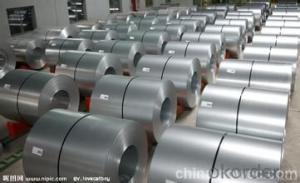excellent cold rolled steel coil / sheet -SPCE
- Loading Port:
- Tianjin
- Payment Terms:
- TT OR LC
- Min Order Qty:
- 30 m.t.
- Supply Capability:
- 5000000 m.t./month
OKorder Service Pledge
OKorder Financial Service
You Might Also Like
Specification:
Thickness: 0.4-2.0mm
2. Width: 900-1250mm
3. Inner Diameter: 508mm
4. Weight of Steel Coil: 3-15MT
5. Heat Treatment: Annealed
6. Margin Status: EC & EM
7. Surface Quality: FB&FC
8. Surface Status: SB & SD
9. Surface Treatment: Oiling
Main Features:
1. Commercial quality suitable for bending fabrication and simple forming; this is the type in greatest demand.
2. Drawing quality second only to that of SPCEN. Excellent uniformity.
3. Deep-drawing quality.With metallurgically controlled grain size, it retains its beautiful finish even after being deep-drawn.
4. Extra-low-carbon steel sheets with highest workability
Application:
1. Refrigerators, cabinets, power distribution baords and drums.
2. Automobile floor and roof panels.
3. Automobile fenders and quarter panels
4. Automobile fenders and quarter panels
Images:


Quality of the goods could be guaranteed. The finished product has a variety of excellent capabilities, such as continuous rolling, degreasing, annealing, skin pass, slitting and cut to length line etc. Along with it many rocessing capability and smooth, flat surface. It’s widely used in outdoor and interior decoration, furnishing
- Q:How are steel coils used in the manufacturing of automotive hoods?
- Steel coils are used in the manufacturing of automotive hoods as the primary raw material. These coils are processed and formed into the desired shape and size to create the hood. The steel's strength and durability make it an ideal choice for automotive hoods, providing protection and structural integrity to the vehicle.
- Q:What really is the difference between stain-less steel and iron? I only know that iron is an element, and stain-less steel is an alloy...but what else is there?
- Steel is iron that is treated with very specific amounts of carbon (sometimes other specific elements are added which results in different types of steel alloy) which results in greatly increased utility in all aspects of the metal.
- Q:How are steel coils used in the production of kitchen appliances?
- Steel coils are used in the production of kitchen appliances as they are transformed into various components such as panels, doors, and frames. These coils are typically cut, shaped, and welded into desired forms, providing strength, durability, and a sleek finish to the appliances.
- Q:I'm a big fan of stainless steel and sterling silver, but not of the humidity of the country I'm in. Therefore I sweat more. Gross, I know. I'm buying a necklace chain for my ring.So does sweat contribute to tarnishing of silver and steel? The real kind?
- steel shouldn't really tarnish, it rusts and moisture increases that. Silver tarnishes when exposed to air and sulfur. Moisture increases the process a bit, but it happens anyway. Sweat is not gross, it's a necessary function of your body, otherwise you would die. A lot of sports people wear jewelry and they sweat a lot. If you wear the jewelry all the time, that will prevent the tarnish a bit. If you take it off, clean it (water and dish washing liquid), dry it and put it in a zip lock back to keep it away from air and moisture. In the end, cleaning the jewelry is quick and easy so don't worry about it.
- Q:what are the characteristics when of iron or steel when stretched? which one could be stretched further? which one stretches more evenly?thankyou
- Technically, this is known as ductility. a material which can be permanently bent and stretched is said to be ductile. Pure iron, when it lacks carbon and impurities like sulfur and phosphorus, is relatively soft, ductile, and weak. It's about as soft as brass. It can be stretched to about 50% of it's original length before it breaks. The amount a sample can be stretched without breaking is known as elongation. The key to steel is the addition of about 2 parts per thousand of carbon, or around 0.2%. This alters the crystal structure and makes steel much harder, stronger, and tougher, though it also becomes somewhat less ductile. Mild steel, with a low carbon content, has an elongation of around 30% Adding more carbon makes the steel yet stronger, but further reduces the elongation. Adding more than 2-3% carbon produces what is known as Cast Iron. Cast iron is brittle. It has virtually no ductility. It's pretty cheap to produce though.
- Q:basically all the info you can find about s1 tool steel i found a bunch about annealing, and hardening, tinsel strength and stuff like that but i need MORE!!!!!
- s1 tool steels (also calles high-speed steels) are used in the manufacture of cutting tools such as drills, reamers, taps, milling cutters, and lathe cutting tools. They are made from different types of steels. They are generally used in machine shops for making holes. .
- Q:Eutectoid Steel
- Eutectic steel is used to produce pearlite, bainite, spheroidite and martensite steels. Those steels vary in strength, hardness and ductility. One uses martensite steel for example in razor blade manufacturing. Of course there is no end to the various uses of these steels.
- Q:How are steel coils used in the production of electrical conduits?
- Steel coils are used in the production of electrical conduits as they serve as the raw material for manufacturing these conduits. The steel coils are processed and shaped into cylindrical tubes, which are then used to protect and enclose electrical wires, ensuring safe and efficient transmission of electricity.
- Q:What are the different methods of coil rewinding for steel coils?
- Coil rewinding for steel coils can be approached in various ways, each with its own merits and considerations. One frequently employed technique is the slitting and rewinding process. This entails slicing the original steel coil into narrower strips, commonly known as "slits," and then winding these slits onto separate reels. Slitting and rewinding grants the ability to customize the width of the coil, making it popular in industries like automotive, construction, and packaging. Another method is oscillate winding. This approach involves rewinding the steel coil in a back-and-forth manner, resulting in a tighter and more compact coil. Oscillate winding proves particularly advantageous in reducing coil deformation during transportation and storage, as well as optimizing material usage. Additionally, the pancake coil winding method finds frequent use for steel coils. This technique involves rewinding the steel coil in a flat, pancake-like shape, making it easier to process and handle. Pancake coils are often employed in applications where space is limited, such as electrical transformers. Furthermore, advanced coil rewinding methods make use of automated equipment, such as robotic systems or computer-controlled winding machines. These technologies ensure precise and consistent rewinding, minimizing human error and enhancing overall efficiency. Ultimately, the choice of coil rewinding method hinges on the specific requirements of the application, including coil dimensions, material properties, and desired production output. Manufacturers must thoughtfully consider factors like coil quality, cost-effectiveness, and equipment capabilities when deciding on the most suitable method for their steel coil rewinding process.
- Q:What are the dimensions of steel coils used in the agricultural structure industry?
- The dimensions of steel coils used in the agricultural structure industry can vary depending on the specific application and requirements. However, commonly used dimensions for steel coils in this industry range from 0.5mm to 3mm in thickness, and from 600mm to 1500mm in width. The length of the coils can also vary, but typically ranges from 1000mm to 3000mm. These dimensions allow for flexibility in the construction of agricultural structures such as barns, sheds, and storage facilities, while providing sufficient strength and durability. It is important to note that specific dimensions may vary depending on the manufacturer and the specific needs of the agricultural project.
1. Manufacturer Overview |
|
|---|---|
| Location | |
| Year Established | |
| Annual Output Value | |
| Main Markets | |
| Company Certifications | |
2. Manufacturer Certificates |
|
|---|---|
| a) Certification Name | |
| Range | |
| Reference | |
| Validity Period | |
3. Manufacturer Capability |
|
|---|---|
| a)Trade Capacity | |
| Nearest Port | |
| Export Percentage | |
| No.of Employees in Trade Department | |
| Language Spoken: | |
| b)Factory Information | |
| Factory Size: | |
| No. of Production Lines | |
| Contract Manufacturing | |
| Product Price Range | |
Send your message to us
excellent cold rolled steel coil / sheet -SPCE
- Loading Port:
- Tianjin
- Payment Terms:
- TT OR LC
- Min Order Qty:
- 30 m.t.
- Supply Capability:
- 5000000 m.t./month
OKorder Service Pledge
OKorder Financial Service
Similar products
New products
Hot products
Related keywords
































